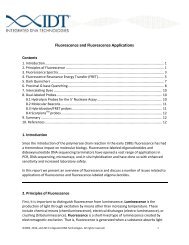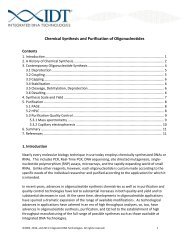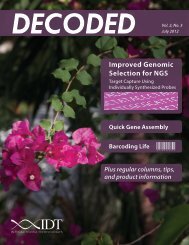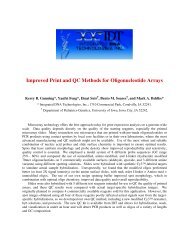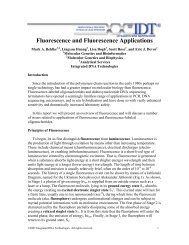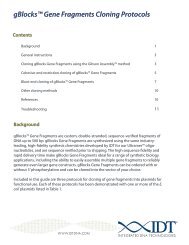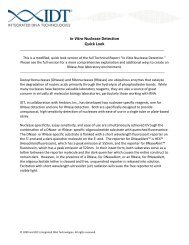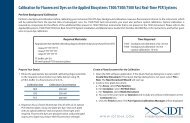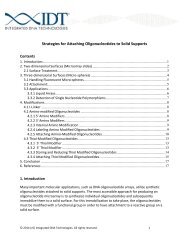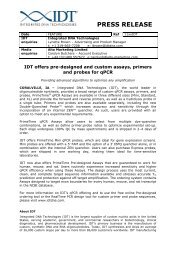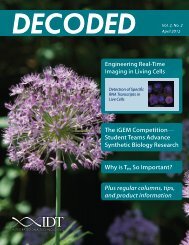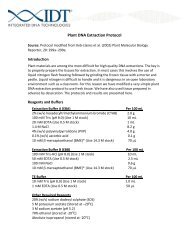Fluorescence Quenching by Proximal G-bases - DNA ...
Fluorescence Quenching by Proximal G-bases - DNA ...
Fluorescence Quenching by Proximal G-bases - DNA ...
You also want an ePaper? Increase the reach of your titles
YUMPU automatically turns print PDFs into web optimized ePapers that Google loves.
<strong>Fluorescence</strong> <strong>Quenching</strong> <strong>by</strong> <strong>Proximal</strong> G-<strong>bases</strong>Mark A. Behlke 1,2 , Lingyan Huang 2 , Lisa Bogh 3 , Scott Rose 2 , and Eric J. Devor 11 Molecular Genetics and Bioinformatics2 Molecular Genetics and Biophysics3 Analytical ServicesIntegrated <strong>DNA</strong> TechnologiesDetection of dye-labeled nucleic acids via fluorescence reporting has become a routinetechnique in molecular biology laboratories. Given this, it is important to note that thequantum yield of fluorophores attached to nucleic acids is dependent upon a number offactors. One of these is the choice of the base that lies adjacent to the fluorescentmolecule. <strong>Fluorescence</strong> quenching <strong>by</strong> an adjacent guanosine nucleotide is anunder-appreciated phenomenon that can significantly effect quantum yield. Dependingupon the fluorophore, this effect can be as much as 40%.The mechanism of fluorophore quenching has been explained <strong>by</strong> electronsharing/donor properties of the adjacent base (Nazarenko et al., 2002). <strong>Quenching</strong> of 2-aminopurine fluorescence in <strong>DNA</strong> is dominated <strong>by</strong> distance-dependent electron transferfrom 2-aminopurine to guanosine (Kelly and Barton, 1999). Seidel et al. (1996) foundthat photo-induced electron transfer plays an important role in this type of quenching.The order of quenching efficiency is GT, if the nucleobase is oxidized (Seidel et al., 1996). Nazarenko et al.(2002) also report that quenching <strong>by</strong> adjacent nucleo<strong>bases</strong> is dependent upon the locationof the fluorophore within the oligonucleotide.We have investigated some of the practical aspects of fluorescence quenching <strong>by</strong> anadjacent guanosine nucleotide. A series of fluorescence-labeled oligonucleotides sharingthe same core sequence was synthesized such that one of three commonly usedfluorophores and each of the four possible adjacent nucleotides was present in eachconstruct (Table 1).The concentration of each oligonucleotide was normalized <strong>by</strong> OD 260 in buffer (10mMTris HCl (pH 8.3), 50mM KCl, 5mM MgCl 2 ). <strong>Fluorescence</strong> measurements were made fora 200nM solution of each oligonucleotide on a PTI (Photon Technologies International)scanning fluorometer. Results for each of the three dyes are presented in figure 1. As canbe seen both 3’ fluorescein and 5’ HEX TM (hexachlorofluorescein) displayed significantquenching when the adjacent nucleotide was guanosine. In contrast, the 3’ Cy3 TM waslittle affected <strong>by</strong> the choice of adjacent nucleotide.©2005 Integrated <strong>DNA</strong> Technologies. All rights reserved. 1
Table 1.Fluorescent Test Oligonucleotides Studied5'-Dye <strong>DNA</strong> Sequence3'-DyeGGAAACAGCTATGACCATA -FluoresceinGGAAACAGCTATGACCATG -FluoresceinGGAAACAGCTATGACCATC -FluoresceinGGAAACAGCTATGACCATT -FluoresceinGGAAACAGCTATGACCATA -Cy3 TMGGAAACAGCTATGACCATG -Cy3 TMGGAAACAGCTATGACCATC -Cy3 TMGGAAACAGCTATGACCATT -Cy3 TMHex TM - TGGAAACAGCTATGACCATHex TM - GGGAAACAGCTATGACCATHex TM - CGGAAACAGCTATGACCATHex TM - AGGAAACAGCTATGACCAT<strong>Fluorescence</strong> intensities at the emission maximum for each dye were normalizedrelative to the value obtained when the adjacent base is adenine. These data are shown infigure 2. Here, it is clear that an adjacent guanosine has the greatest affect on all threefluorophores even though it is minimal for Cy3 TM . These results suggest that adjacentguanosine nucleotides should be avoided when designing oligonucleotides that contain afluorescent reporter molecule.ReferencesKelley, S.O. and Barton, J.K. (1999) Electron Transfer between <strong>bases</strong> in double helical<strong>DNA</strong>. Science 283:375-381.Nazarenko, I., Pires, R., Lowe, B., Obaidy, M., and Rashtchian, A. (2002) "Effect ofPrimary and Secondary Structure of oligodeoxyribonucleotides on the fluorescentproperties of Conjugated dyes. Nuc. Acids. Res. 30:2089-2195.Seidel, C.A.M., Schulz, A., and Sauer, M.H.M.(1996) Nucleobase-Specific <strong>Quenching</strong> ofFluorescent Dyes. 1. Nucleobase One-Electron Redox Potentials and Their Correlationwith Static and Dynamic <strong>Quenching</strong> Efficiencies. J. Phys. Chem. 100:5541-5553.©2005 Integrated <strong>DNA</strong> Technologies. All rights reserved. 2
Fig. 1. Scanning fluorometer results obtained with the oligonucleotide constructs shown in Table 3.Fig. 2. Relative fluorescence intensities of FAM TM , HEX TM , and Cy3 TM as a function of the nucleotideadjacent to the fluorophore.©2005 Integrated <strong>DNA</strong> Technologies. All rights reserved. 3



